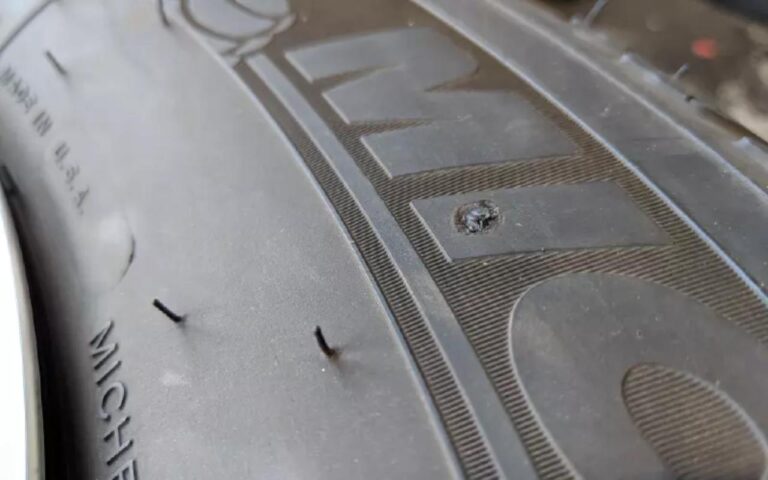Ditching a newly bought tire that acquired sidewall damage sounds like a complete waste of money if you get a replacement. Is fixing a damaged sidewall the best idea? Can you patch a hole in the sidewall of a tire?
In today’s modern age, anything is possible. Yes, you can patch a minor hole in the tire’s sidewall using a plug kit and a rubber cement that comes with it. However, enthusiast drivers and tire experts do not recommend it for safety reasons.
The Tire Industry Association expresses that you must not repair any damage on the tire’s sidewall. However, patching your sidewall may help you get to the nearest tire shop to get a replacement.
If you got stranded in an area where you cannot get a replacement tire and the hole is reparable, a quick fix kit will keep you moving.
Read on to learn some information on how sidewall repair works.
What Causes a Hole in the Sidewall?
Before further discussing how to repair a hole in the tire sidewall, let us first discover how a tire could get a puncture in this area.
Any sharp objects that press against your tire sidewall could potentially create damage or a hole. It could be a nail, a stone, broken glass, or any road debris.
I remember getting a hole on my tire sidewall one time when I drove across a construction site. A construction staple managed to bite the shoulder and the sidewall of my tire, creating a small hole.
Another potential culprit of a hole in the tire sidewall is road potholes. The amount of damage a road pothole could give your tires is beyond imaginable. So, avoid it as much as you can, or else you will end up replacing your tire, worse, your rim.
Potholes not only cause misalignment. There are sharp objects in them on some occasions, like a protruding steel bar, nail, screw, or sharp stone. These objects could potentially puncture your tire’s sidewall.
Another possible cause is vandalism. You could be living in a not-so-friendly neighborhood, or you might have gone to an area where people are not very accommodating. Although the chance of this happening is very slim, in reality, it still happens.
I once passed by a parked car where kids played with spare woods full of nails and tried to hammer them on the vehicle’s tire. That was not a very pleasant scenario for car owners.
Regardless of the reasons your tire can acquire a hole in the sidewall, what is extremely important is to be cautious all the time. Look at the road you are taking and park your vehicle at a safer place.
Also, read our view on outstanding highway tires from Michelin: Defender LTX M/S
How to Fix a Hole in Tire Sidewall
At the beginning of this article, I used “minor hole” to emphasize that severe sidewall damage is beyond repair. Of course, you cannot fix sidewall holes all the time as it depends on how large it is. Generally, you can still remediate a puncture that is 1/4 inch or less.
The most popular way to fix a hole in a tire sidewall is using rubber cement.
Rubber cement is an adhesive that is widely used in the tire industry to fix tire damages. You can purchase this from any auto shop or online store.
What is the application process?
First, you need to buy a tire plug kit from any auto parts store along with a tube of rubber cement. I would suggest you keep these in your trunk for emergency purposes. They can be the solution if you run into a bad day with your tire.
The next step is to check the puncture or the hole and ensure that you have removed the culprit completely. Removing the object would rapidly release the air from your tire, so you might need to do it fast and apply the plug quickly.
Then, apply the rubber cement into the puncture by using the available tool in the kit. You must have the complete application instruction when you purchase the kit.
I will provide more detailed instructions on how to do this in the following section. The final goal is to completely seal the hole and block the air from popping out of the tire.
This YouTube video shows you how to repair sidewall damage easily. Of course, this video only intends to give you some ideas on how to do it. If you decide to do it, you do it at your own risk.
Let us talk more about the process of plugging the hole in your tire sidewall.
Plugging a Hole in the Tire Sidewall
As mentioned earlier, plugging and using rubber cement could be the most convenient way to fix the hole in your tire’s sidewall. Let us take a closer look at the process of doing it.
Before you start, you need to ensure that you have the necessary tools to carry out the job. What are these tools? These are tools that you always have in your car trunk, including a car jack, pliers, wire cutters, and tire plugging kit.
You must also have the required materials like the tire plug strips and the tire sealing cement.
Step 1: Considering that you already know where the hole is, you must first remove the object from the hole using your pliers.
Step 2: Using your T-handle reaming tool (which should be in the plug kit), roughen the inner surface of the hole. The process involves jamming it into the hole, working it up and down, and rotating it several times.
Step 3: Thread the plug strip into the eyelet of the insertion tool using your pliers until it protrudes equally on each side.
Step 4: Apply the tire sealing cement on the plug strip and the hole on the tire sidewall.
Step 5: Insert the cement-coated plug strip slowly into the hole. It might require some force to do it successfully. Press hard until the plug gets into the hole. You can carefully pull up the insertion tool when it has reached at least about an inch into the hole.
Step 6: Refill the tire with air to test it out. You can use water with sope to see if the air still pops out of the hole. If the air is still coming out of the tire, it indicates that you did not do it properly and might need some professional help or replace your tire.
Step 7: If no more leaks, cut out the plug strip and clean the area from the excess tire cement.
If you are the type of person who wants to see a demonstration, I looked up a video that would give you an example of how to do this. Examine the video below and see if it gives you an idea of how to perform this.
If you are not confident in doing the process above, you can always tap on someone who has done it before. Alternatively, you can get the help of a mechanic who perfectly knows the process.
Dangers of Using a Tire with Repaired Hole in the Sidewall
It is never safe to drive a tire that lost integrity because of damage like a hole in the sidewall. The sidewall of your tire plays a crucial role, and if its performance is compromised, it is dangerous.
Sometimes we think the damage is minimal and that the tire can survive with the help of a repair. Then, it is too late already when we experience the tire has failed in the middle of the road.
A tire with a repaired sidewall can still potentially blow up at any given time.
We’ve discussed using a plug kit and rubber cement to fix a hole on a tire sidewall. Yes, it may work occasionally, but the tire’s performance will never be the same. Knowing that your tire went through some repair, you will not be confident enough to load up your vehicle as the issue might reoccur.
In other words, you will not have peace of mind while driving because of the imminent danger that may happen any time while you roll on the road.
So, as I have been reiterating, a sidewall repair must only be temporary. You must only do it if you don’t have access to a new tire for a replacement. Never compromise your safety by settling with a repaired tire. Don’t be cheap with your life.
Conclusion
Patching a hole in the sidewall of a tire is not recommended for safety reasons. However, it can be a simple solution if you bump into a situation where you don’t have any other option, like being far from tire shops to buy a replacement.
The use of a plug kit and tire rubber cement is the most viable and convenient solution. However, it would be best if you acknowledged that this fix might not last long and guarantee your safety. The ideal thing to do is to replace the damaged tire.

